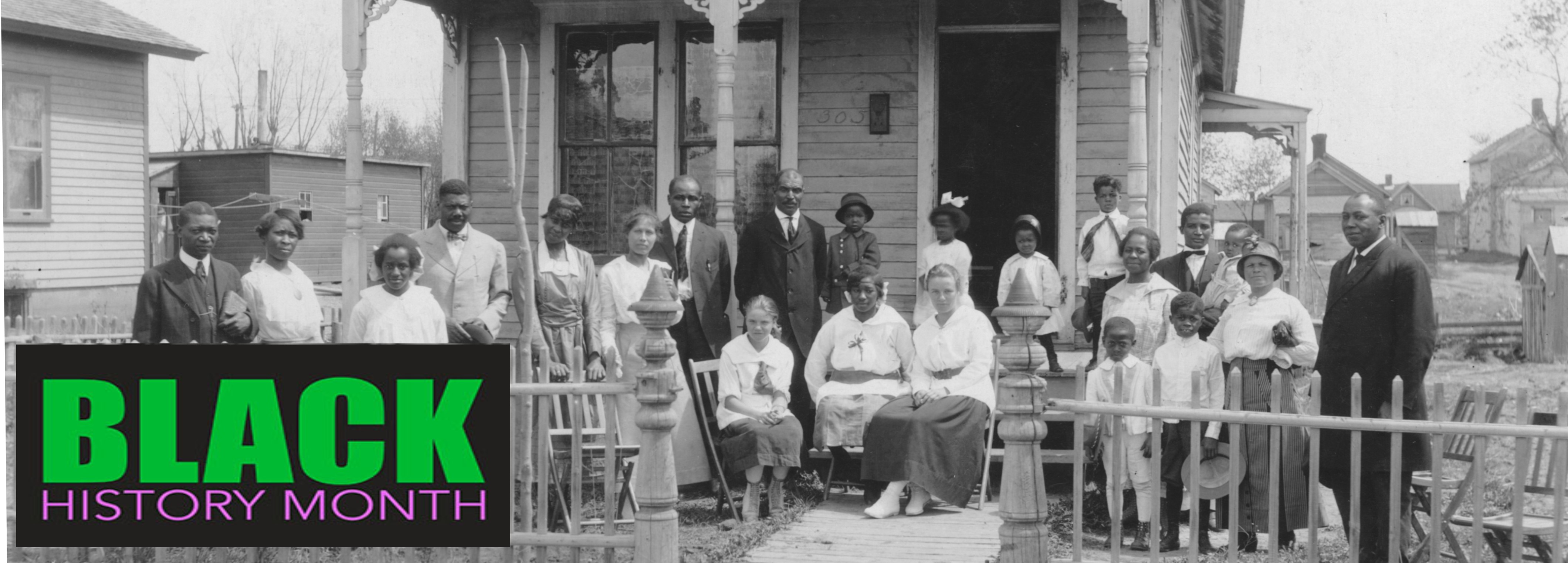
Second Baptist Church, Bismarck, N.D., State Historical Society of North Dakota (00739-v1-14b)
February is Black History Month
“National Black History Month serves as both a celebration and a powerful reminder that Black history is American history, Black culture is American culture, and Black stories are essential to the ongoing story of America—our faults, our struggles, our progress, and our aspirations.” President Biden (declared by Presidential Proclamation 10337)
- Mapping Black History in North Dakota
-
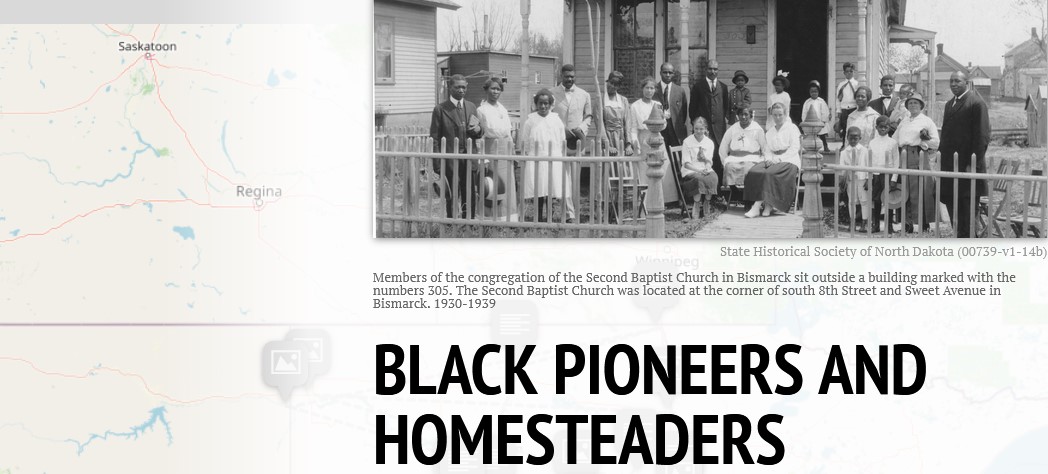
story map to highlight some of the many African Americans who have come to North Dakota. More will be added to this map over time.
-
North Dakota Baseball
-
Enderlin Historical Society and Museum, Inc. (EN-1)
In the 1880s the 25th Regiment of United States Infantry were mostly active in the Dakota Territory, Minnesota, and Montana. Inspired by a game at Fort Buford, North Dakota, Colonel Andrew S. Burt formed a regimental baseball team with the 25th. These regimental teams were integrated.
"During the 1890s, most professional black players were limited to playing in exhibition games on "colored" teams on the barnstorming circuit. Players on major league teams also barnstormed in cities and towns after the regular season was over. In some places black teams and white teams played each other, and some blacks played for all-black teams in otherwise all-white leagues." - Jackie Robinson and Other Baseball Highlights, 1860s-1960s
In the 1920-1930 some teams in North Dakota were integrated, including the short-lived (1933-1935) Bismarck team. The Bismarck team included Satchel Paige, Barney Brown, and Quincy Trouppe.
Sunday afternoons on the prairie : the growth of baseball in North Dakota
Color blind : the forgotten team that broke baseball's color line - Era Bell Thompson
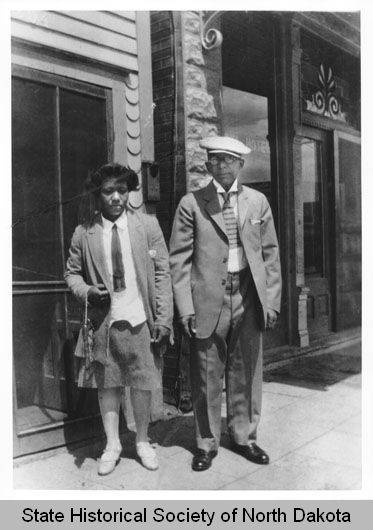
State Historical Society of North Dakota (00262-004) Era Bell Thompson (1905-1986)
In 1914 Era Bell's family moved from Iowa to Driscoll North Dakota. Three years after arriving in North Dakota her mother died and the family moved to Mandan and then Bismarck where her father worked for Governor Lynn Frazier as a private messenger. After graduating from Bismarck High she attended UND for two years starting in 1925. She was a talented athlete, setting five UND track records and tied two national records. She was also a reporter for the Dakota Student newspaper and eventually became an editor of Ebony magazine. She wrote about her experience in North Dakota and her professional life in American Daughter.
On August 14, 1976 she was presented with the Theodore Roosevelt Rough Rider Award .The award recognizes North Dakotans who achieve national recognition in their field. The multicultural center at the University of North Dakota - Grand Forks was named after her and she was inducted into the UND Athletic Hall of Fame in 1986.
Read more works by and about Era Bell Thompson:
White on black; the views of twenty-two white Americans on the Negro.
Thompson, Era Bell.; Nipson, Herbert. 1963. Available at NDSU Main Library. - William Thornton Montgomery
-
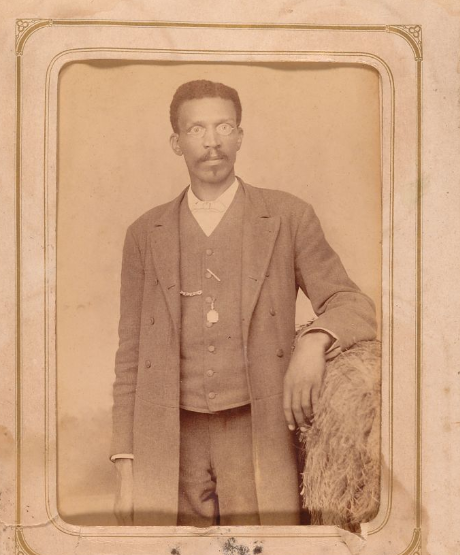
(Image from the Mississippi Department of Archives and History, Crowe (Milburn J.) Photograph Album PI/2005.0015)
William Thornton Montgomery (1843-1909)
Civil War veteran, William T. Montgomery served on the US Navy vessel Carondelet from 1864-1865. His father was Benjamin Montgomery, a slave of Joseph Davis who was able to buy the Davis plantation after emancipation. He would eventually become one of the largest plantation owners in Mississippi before losing his land after a series of crop failures. He had two sons, William, and Isaiah T. Montgomery who would found the successful African American community of Mound Bayou.
After serving in the Navy, William Montgomery worked with his father and brother in their mercantile business Montgomery & Sons. After the loss of the plantation and business Montgomery "moved to Dakota Territory where purchased 640 acres (one section) from the Chicago, Milwaukee, and St. Paul Railway. The land was located in Eagle Township of Richland County. It was good land, two miles from Red River. Montgomery eventually increased his land holdings to 1,020 acres. He located his home near the northern boundary of his land holdings. He built a grain elevator nearby. A community grew up around his home and elevator which he named Lithia, after his mother. Montgomery’s substantial land holdings earned him notice from the territorial government as “commissioner for the colored department” representing Dakota at the 1884 New Orleans Industrial and Cotton Centennial Exposition."
Montgomery lived in North Dakota till around 1897 when he moved to Mount Bayou where he died and was buried in 1909.
Read More:
- Althea Catherine Cater
-
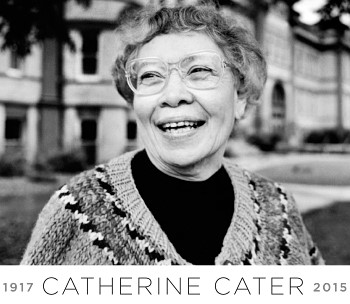
Althea Catherine Cater (1917-2015)
Catherine Cater was born in New Orleans on March 18, 1917. Her father, James Tate Cater, was a mathematician and dean of Talladega College in Talladega, Alabama. Her mother, Daisy Frances Rochon Cater, died when Catherine was still a young child. Following her mother’s death, Catherine spent some time with relatives in Chicago and New York, before returning to live with her father in Talladega. She spent most of her youth and teen years on the Talladega campus, attending the elementary and high schools there. Her father was dean of the integrated Talladega College at a time when integration was a very controversial issue. Catherine has memories of her family rushing to hide her under a bed as the Ku Klux Klan marched through campus. However, she also remembers her father’s admiration of W.E.B. DuBois, with whom he had studied at Atlanta University, and Langston Hughes, who included a poem by Catherine in one of his anthologies. Catherine was deeply influenced by her father, who promoted some of the most progressive ideas in education at the time. He and Catherine were both inspired by the ideas of Robert Maynard Hutchins, president of the University of Chicago and later head of the Center for the Study of Democratic Institutions. Hutchins “believed that anyone with normal capacities can read and appreciate the great books, and understand and communicate great ideas” (Howard Binford’s Guide, Sep. 1983, p.21).
Catherine entered the undergraduate program at Talladega College in 1934, majoring in English literature and minoring in philosophy. Following her graduation from Talladega in 1938, she enrolled at the University of Michigan in Ann Arbor to pursue graduate studies. At the University of Michigan, she earned her Master of Arts degree in English Language and American Literature, graduating in 1939. In addition she also received a Bachelor of Arts in Library Science in 1940, and a Doctorate of Philosophy in English Language and Literature in 1945. Her first full time job after college was at Fisk University in Nashville, Tennessee, where she worked as a circulation librarian and taught freshman English classes. After three years at Fisk, she was awarded the prestigious Rosenwald Fellowship, which provided money for her to continue her studies.
Armed with her new doctorate degree, she obtained a teaching job at Olivet College in Olivet, Michigan. In the fall of 1948, Catherine resigned from Olivet when the school came under attack for engaging in Communist “un-American” activities. She next moved to Moorhead, Minnesota, to teach at Moorhead State Teachers College. Catherine worked as a reference librarian and taught English classes at the Moorhead school (Moorhead State University). In 1962, Catherine left Moorhead to take a teaching job at North Dakota State University (NDSU) in Fargo, North Dakota. At NDSU, she taught English and humanities classes, becoming a full professor there in 1963. In the spring of 1982, Catherine “retired” from NDSU, and was made Professor Emeritus of English. Her retirement has not kept Catherine from teaching, however; in fact, since 1982, she has continued to teach at least one class each semester. In 2001, NDSU awarded her an honorary Doctor of Fine Arts degree in recognition of her dedication to teaching and her promotion of the humanities.
Read more:
Catherine Cater : an elegant rise above race and gender as scholar and professor
Dr. Catherine Cater REDUX; We Remember
- NDSU events

- Official Black History Month Site
-
February is Black History Month
The Library of Congress, National Archives and Records Administration, National Endowment for the Humanities, National Gallery of Art, National Park Service, Smithsonian Institution and United States Holocaust Memorial Museum join in paying tribute to the generations of African Americans who struggled with adversity to achieve full citizenship in American society. Check this site for virtual events!
- Mardi Gras Indians
-
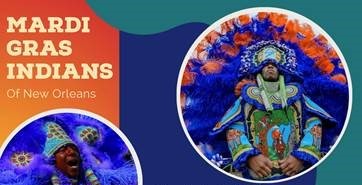
Mardi Gras Indians of New Orleans

Historically, local indigenous tribes hid and provided refuge for runaway African slaves. Mardi Gras Indians honor the history of the two cultures, because of the common experiences that both Black and indigenous communities share.
Comprised of African American members, Mardi Gras Indians participate in performances and parades throughout Carnival season. This tradition began in the eighteenth century. Each suit is hand sewn with elaborate bead work depicting a symbolic scene. Feathers and sequins are part of a Mardi Gras Suit. A suit usually takes up to nine months to complete, and can weight more than seventy pounds.
The New Yorker website is streaming this documentary: All on a Mardi Gras Day (contains strong language)
"Filmed in a gentrifying New Orleans, Michal Pietrzyk’s “All on a Mardi Gras Day” is an intimate portrait of Demond, who performs as a Mardi Gras Indian, as he spends the entire year painstakingly handcrafting his suit for the big parade."
Learn more about Mardi Gras and Masking in this video.
- Learn more about African American History and Culture
-
National Museum of African American History and Culture: The Searchable Museum
The Smithsonian's National Museum of African American History and Culture (NMAAHC) launched its newest digital initiative, the Searchable Museum. The Searchable Museum reaches beyond the walls of the museum to provide a rich digital experience that includes a multimedia presentation of NMAAHC's historical narratives, collections and educational resources. This initiative is one of the museum's largest digital undertakings, bringing the museum's evocative content and immersive in-person visitor experience into homes around the world.

